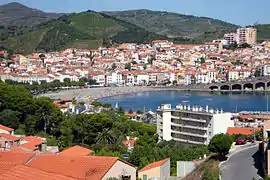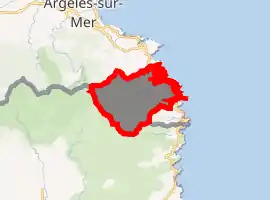Banyuls-sur-Mer
Banyuls-sur-Mer (French pronunciation: [baɲuls syʁ mɛʁ] (![]() listen); Catalan: Banyuls de la Marenda) is a commune in the Pyrénées-Orientales department in southern France. It was first settled by Greeks starting in 400 BCE.
listen); Catalan: Banyuls de la Marenda) is a commune in the Pyrénées-Orientales department in southern France. It was first settled by Greeks starting in 400 BCE.
Banyuls-sur-Mer | |
|---|---|
 A general view of Banyuls-sur-Mer | |
.svg.png.webp) Coat of arms | |
Location of Banyuls-sur-Mer 
| |
 Banyuls-sur-Mer  Banyuls-sur-Mer | |
| Coordinates: 42°28′59″N 3°07′41″E | |
| Country | France |
| Region | Occitanie |
| Department | Pyrénées-Orientales |
| Arrondissement | Céret |
| Canton | La Côte Vermeille |
| Intercommunality | Communauté de communes des Albères et de la Côte Vermeille |
| Government | |
| • Mayor (2020–2026) | Jean-Michel Solé |
| Area 1 | 42.34 km2 (16.35 sq mi) |
| Population (2017-01-01)[1] | 4,761 |
| • Density | 110/km2 (290/sq mi) |
| Time zone | UTC+01:00 (CET) |
| • Summer (DST) | UTC+02:00 (CEST) |
| INSEE/Postal code | 66016 /66650 |
| Elevation | 0–965 m (0–3,166 ft) (avg. 6 m or 20 ft) |
| 1 French Land Register data, which excludes lakes, ponds, glaciers > 1 km2 (0.386 sq mi or 247 acres) and river estuaries. | |
Geography
Location
Banyuls-sur-Mer is located in the canton of La Côte Vermeille and in the arrondissement of Céret.
Banyuls-sur-Mer is neighbored by Cerbère, Port-Vendres, Argelès-sur-Mer and Collioure on its French borders, and by Espolla, Rabós, Colera and Portbou on its Spanish borders. The foothills of Pyrenees, the Monts Albères, run into the Mediterranean Sea in Banyuls-sur-Mer, creating a steep cliff line.

Neighbouring communes
Toponymy
Banyuls-sur-Mer was first mentioned in 981 as Balneum or Balneola. In 1074, the town started being called Bannils de Maritimo in order to distinguish it from Banyuls-dels-Aspres, which lies 20 km (12 mi) away. In 1197, the town was mentioned as Banullis de Maredine and in 1674. In Catalan, it has been called Banyuls de la Marenda since the 19th century.
The name Banyuls indicates the presence of a pond. In fact, a pond did exist in Banyuls-sur-Mer until the creek Vallauria was drained in 1872. The term Marenda in Catalan or sur Mer in French merely indicates the proximity to the coast.
History
In the 20th century Banyuls-sur-Mer was the site of a camp housing Republican escapees from Spain at the end of the Spanish Civil War.[2]
Government and politics
Mayors
| Mayor | Term start | Term end |
|---|---|---|
| René Ribère | 1977 | 1983 |
| Jean Rède | 1983 | 1995 |
| Pierre Becque | 1995 | 2001 |
| Roger Rulls | 2001 | 2008 |
| Jean Rède | 2008 | 2014 |
| Jean-Michel Solé | 2014 |
International relations
Banyuls-sur-Mer is twinned with a small town called Settle, which is in North Yorkshire, United Kingdom and also with the town of Kralupy nad Vltavou located in the Central Bohemian Region of the Czech Republic.
Demography
.jpg.webp)
| Year | Pop. | ±% |
|---|---|---|
| 1836 | 2,022 | — |
| 1901 | 3,111 | +53.9% |
| 1962 | 4,271 | +37.3% |
| 1968 | 4,436 | +3.9% |
| 1975 | 4,000 | −9.8% |
| 1982 | 4,093 | +2.3% |
| 1990 | 4,662 | +13.9% |
| 1999 | 4,532 | −2.8% |
| 2006 | 4,632 | +2.2% |
| 2009 | 4,686 | +1.2% |
| 2015 | 4,771 | +1.8% |
Sports
- Banyuls-sur-Mer is at the eastern end of the GR 10 long-distance footpath.[3]
- Banyuls is a centre for scuba diving. The main dive site of the area is the marine reserve at Cap Rederis. Local dive schools offer excellent facilities.
- Sea kayaking is also available here.
Economy
For nearly two centuries, the smuggling of goods to and from Spain was a major activity in Banyuls-sur-Mer. Depending on the needs of the time, salt, tobacco, silver, sugar, rice, textiles, and leather were smuggled through this city, almost always with impunity. Otherwise the inhabitants lived mainly from fishing and viticulture. Nowadays, tourism stemming from the wine industry plays a significant economic role in the town, notably for delicious and rare red dessert wines. Under the Collioure appellation, the town is also a centre of quality dry reds, rosés and whites, with a number of producers of naturally sweet wines.
George Orwell and his wife Eileen had a holiday in Banyuls-sur-Mer directly after leaving Spain, then in the throes of its civil war, in July 1937. Their holiday was not a success. As he noted, Orwell found the place 'a bore and a disappointment'. It was chilly weather, a persistent wind blew off the sea, the water was dull and choppy....[4]
Sites of interest
- Musée Maillol Banyuls-sur-Mer, a private museum at the farm of the sculptor Aristide Maillol where he is buried.
Notable people
- Aristide Maillol (1861-1944), French sculptor and painter, born and died in Banyuls-sur-Mer. Maillol was very much part of the turn of the century art scene, friends with Matisse, Derrain, Picasso, Dali. A sculpture of Dina Vierny, aged 17, his last muse, model, and member of the French Resistance, stands beneath the huge jacaranda tree behind the town hall.[5]
- Emil Racovita (1868-1947), Romanian polar explorer, former co-director of the Arago laboratory.
- Jean de La Hire (1878-1956), writer born in Banyuls-sur-Mer.
- Marc Eyraud (1924-2005), actor, died in Banyuls-sur-Mer.
- Édouard Chatton (French pronunciation: [edwaʁ ʃatɔ̃]) (11 October 1883 – 23 April 1947, Banyuls-sur-Mer) was a French biologist who first characterized the distinction between the eukaryotic and prokaryotic systems of cellular organization. Chatton coined the terms in his 1925 paper, Pansporella perplex: Reflections on the Biology and Phylogeny of the Protozoa.
References
- "Populations légales 2017". INSEE. Retrieved 6 January 2020.
- Beevor, Antony (2001). The Spanish Civil War. London: Cassell Military Paperbacks. p. 394. ISBN 0 304 35840 1.
- "Banyuls-sur-Mer".
- Shelden, Michael (1991). ORWELL : : THE AUTHORIZED BIOGRAPHY (First ed.). New York, NY: HarperCollins. p. 277. Retrieved 2014-08-18.
- "Banyuls-sur-Mer".